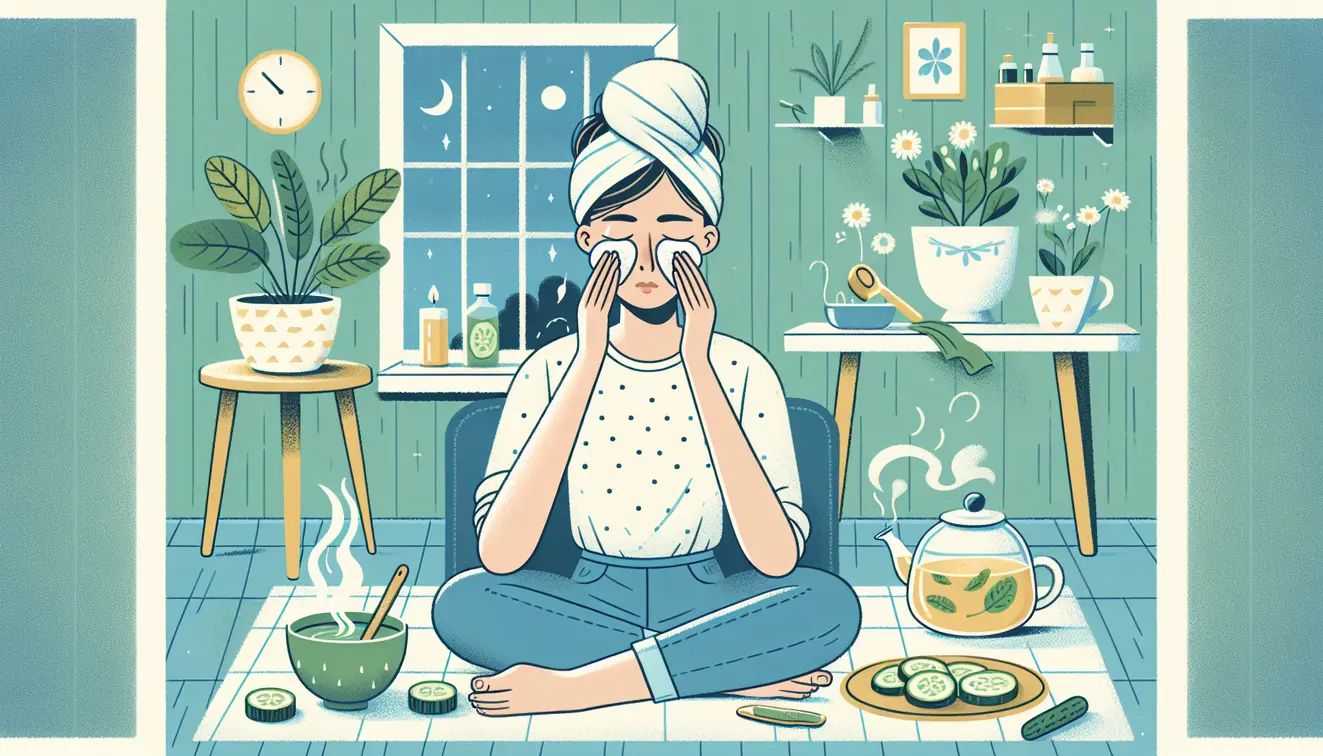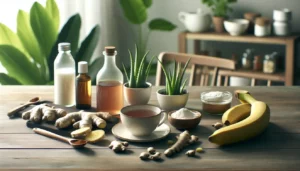Estimated reading time: 10 minutes
Welcome to WikiHomeRemedies, your trusted companion in exploring nature’s healing potential. If you’re dealing with pinkeye, also known as conjunctivitis, you’re likely searching for relief from that uncomfortable redness and irritation. We’re here to guide you through safe, evidence-backed home remedies that can ease symptoms and support recovery. Let’s walk this path together, ensuring you feel cared for every step of the way.
Before we dive in, a gentle reminder: while home remedies can soothe discomfort, they don’t replace professional medical advice. If symptoms worsen or persist, reaching out to a healthcare provider is vital. Our goal is to empower you with reliable solutions, grounded in research from sources like the Mayo Clinic and WebMD, while prioritizing your safety.
Key Takeaways:
- Home remedies can effectively soothe mild pinkeye symptoms but are not a substitute for medical care when symptoms are severe or persistent.
- Simple solutions—such as warm compresses, saline rinses, and safe, gentle applications (like diluted honey or chamomile)—offer symptom relief for many types of conjunctivitis.
- Rigorous hygiene is essential to prevent the spread and recurrence of infection.
- Some widely suggested remedies, including breast milk or undiluted essential oils, are not safe or effective.
- If you notice worsening pain, vision changes, or symptoms that linger, seek professional help promptly.
Table of Contents
- Introduction to Pinkeye and the Value of Home Remedies
- Understanding Pinkeye: Causes, Symptoms, and Types
- The Role of Home Remedies in Managing Pinkeye
- Top Evidence-Based Home Remedies for Pinkeye
- Essential Hygiene Practices to Support Recovery
- Home Remedies to Avoid: Debunking Common Myths
- Complementary Tips for Faster Pinkeye Relief
- When Home Remedies Aren’t Enough
- Frequently Asked Questions (FAQs) About Pinkeye Remedies
- Additional Resources for Pinkeye and Eye Health
Introduction to Pinkeye and the Value of Home Remedies
Pinkeye, or conjunctivitis, happens when the thin membrane covering your eye and inner eyelid, called the conjunctiva, becomes inflamed. This common condition affects millions in the U.S. each year, often leaving eyes red, itchy, or gritty. It can stem from viruses, bacteria, or allergens, and while it’s usually not serious, the discomfort can disrupt your day.
Many turn to home remedies for pinkeye because they’re accessible and often cost less than a doctor’s visit. There’s also a growing preference for natural approaches that feel gentle on the body. Whether it’s a warm compress or a saline rinse, these solutions can calm irritation without harsh chemicals for mild cases.
Our purpose here at WikiHomeRemedies is to share safe options for symptom relief, backed by trusted information. However, we must stress the importance of caution. If you notice severe pain or vision changes, please consult a healthcare professional promptly. Let’s build a foundation of understanding before exploring remedies tailored to your needs.
Understanding Pinkeye: Causes, Symptoms, and Types
Knowing what triggers pinkeye helps in managing it wisely. It often starts with a virus, like adenovirus, which spreads easily through contact. Bacteria such as staphylococcus can also cause it, often leading to a sticky discharge. Then there’s allergic pinkeye, sparked by pollen or pet dander, which tends to affect both eyes with intense itching.
Symptoms are hard to miss. Your eyes may turn red, feel scratchy, or produce a discharge that crusts overnight. Some experience sensitivity to light, making sunny days tough. Recognizing these signs early can guide you toward the right care.
Pinkeye comes in three main forms. Viral is highly contagious and often clears on its own. Bacterial might need medical treatment due to thicker discharge. Allergic pinkeye ties to environmental triggers and isn’t contagious. Each type needs a slightly different approach for relief.
There are moments when home care isn’t enough. If you feel intense pain, see vision blurriness, or symptoms linger beyond a few days, seek medical help. The National Institutes of Health note that viral pinkeye makes up most cases, but complications can sneak in if ignored. Let’s keep that in mind as we move forward.
The Role of Home Remedies in Managing Pinkeye
Home remedies shine when it comes to easing pinkeye symptoms. They can soften the sting of irritation, lessen swelling, and keep your eyes feeling fresher. Think of them as supportive tools that work alongside your body’s natural healing.
Yet, it’s key to know their limits. These remedies won’t eradicate a bacterial infection needing antibiotics or stop a severe viral spread. They’re best for mild cases or as a complement to prescribed care, not a standalone cure.
Safety and hygiene are non-negotiable. Always wash your hands before touching your eyes to prevent worsening the condition or passing it on. Using clean materials for any remedy is crucial. With guidance from sources like the Mayo Clinic, we’ll ensure these practices support your recovery as we explore specific solutions next.
Top Evidence-Based Home Remedies for Pinkeye
Let’s delve into practical remedies that can bring comfort. Each option below is chosen for its potential to ease symptoms, backed by insights from credible platforms like Healthline and WebMD. Follow the steps carefully, and always keep hygiene at the forefront.
Warm and Cold Compresses
A simple compress can work wonders for irritated eyes. Warmth helps loosen crusty discharge, especially with bacterial pinkeye, while a cool compress soothes swelling and itching from allergic types. It’s a straightforward way to find relief.
To apply, soak a clean cloth in warm or cool water, wring it out, and place it over closed eyes for 5 to 10 minutes. Use separate cloths for each eye to avoid spreading infection. Never reuse without washing in hot water first.
Saline Solution Rinse
A saline rinse cleanses the eye gently, washing away irritants or discharge. It mimics the body’s natural tears, making it safe for most. This can be especially calming for viral or allergic pinkeye.
Mix a teaspoon of non-iodized salt in a cup of boiled, cooled water. Use a clean dropper or cotton ball to apply, letting it flush over the eye. Ensure everything is sterile to prevent introducing new irritants.
Honey Solution (Antibacterial Properties)
Honey carries natural antibacterial traits, noted by studies referenced on Healthline. It may help with bacterial pinkeye by reducing minor irritation when used cautiously. Its sticky texture can also trap debris for removal.
Dissolve a small spoonful of raw, organic honey in a cup of warm, boiled water. Once cooled, apply with a clean cloth or dropper. Avoid direct eye contact with undiluted honey, as it can sting. Wash hands after use.
Chamomile Tea Compress
Chamomile is known for calming inflammation, offering a gentle touch for swollen eyes. Its mild properties can ease the puffiness often tied to allergic pinkeye. This remedy feels like a soft hug for tired eyes.
Brew a chamomile tea bag in hot water, let it cool completely, then place the damp bag over closed eyes for 10 minutes. Ensure it’s not hot to avoid burns. Use a fresh bag per session to keep things clean.
Aloe Vera Gel (Cooling Effect)
Aloe vera brings a cooling sensation, ideal for reducing redness or heat in the eyes. Medical News Today highlights its soothing nature, which can help with mild irritation. It’s a refreshing option for many.
Extract fresh gel from an aloe leaf or use pure, store-bought gel. Dab a small amount around the eye with a clean cotton swab, avoiding direct contact inside. Wipe off residue with a damp cloth to stay tidy.
Cucumber Slices for Puffiness
Cucumber slices offer a cooling fix for puffy, irritated eyes, often from allergic reactions. Their high water content hydrates the skin around the eye, bringing down swelling. It’s a classic trick for a reason.
Chill a cucumber in the fridge, slice it thinly, and place slices over closed eyes for 10 minutes. Wash your face afterward to clear any residue. Use fresh slices each time to maintain cleanliness.
Tea Tree Oil (Diluted for Safety)
Tea tree oil has antimicrobial effects but must be used with care. When diluted properly, it may support hygiene around the eye area for bacterial cases. Mishandling can irritate, so precision matters.
Mix a drop of tea tree oil with a tablespoon of carrier oil like coconut oil. Apply around the eye, not inside, using a clean swab. Wash hands thoroughly after and avoid overuse to prevent sensitivity.
Artificial Tears (OTC Option)
Over-the-counter artificial tears, as suggested by WebMD, mimic natural lubrication to ease dryness and grit. They’re safe for viral or allergic pinkeye, flushing out minor irritants. This is an easy, accessible choice.
Purchase preservative-free drops from a pharmacy. Follow package instructions, usually applying 1-2 drops per eye. Avoid sharing the bottle or touching the tip to your eye to keep it sterile.
Essential Hygiene Practices to Support Recovery
Healing from pinkeye isn’t just about remedies; cleanliness plays a huge role. Without proper habits, recovery slows, or the infection spreads. Let’s cover key steps to protect yourself and others, inspired by advice from the Cleveland Clinic.
Start with personal hygiene. Wash your hands often with soap for at least 20 seconds, especially after touching your face. Don’t rub your eyes, as this can worsen irritation or transfer germs. Use a fresh towel or tissue each time you wipe your face.
In your home, take precautions to limit spread. Wash bedding, pillowcases, and towels in hot water regularly. Don’t share personal items like washcloths or makeup. Disinfect surfaces you touch often, like doorknobs or phones, to keep germs at bay.
If your pinkeye is contagious, consider isolation measures. Avoid close contact with family or friends, especially young children who catch it easily. Stay home from work or school until symptoms improve. These steps ensure the infection doesn’t linger or affect others.
Home Remedies to Avoid: Debunking Common Myths
Not every remedy you hear about is safe. Some popular ideas can harm more than help, risking further irritation or infection. We’re here to clear the air with insights from Medical News Today.
Steer clear of unsafe practices like applying breast milk, undiluted essential oils, or even spit to the eye. These can introduce bacteria or cause harsh reactions, worsening your condition. The risks outweigh any rumored benefits.
Why do these myths stick around? Often, they’re passed down through stories or misinformation online. Without scientific backing, they persist despite evidence against them. Trusting unverified tips can delay proper care.
Instead, rely on the safe alternatives we’ve shared earlier, like saline rinses or compresses. These align with trusted health guidelines and pose no threat. Stick to what’s proven to guard your well-being.
Complementary Tips for Faster Pinkeye Relief
Beyond remedies, small lifestyle tweaks can support healing. Your body needs fuel and rest to fight off irritation or infection. Let’s explore ways to enhance recovery naturally.
Focus on diet to bolster your immune system. Foods rich in vitamin C, like oranges, or anti-inflammatory options, such as spinach, can aid repair. Omega-3 sources like salmon may also tame swelling around the eyes.
Hydration and rest are just as vital. Drink plenty of water daily to keep your system running smoothly, and aim for 7-8 hours of sleep. This gives your eyes a break and boosts overall recovery.
Avoid irritants that slow progress. Stay away from smoky areas, allergens like pollen if possible, and chlorinated pools. Protecting your eyes from extra stress ensures remedies work better and faster.
When Home Remedies Aren’t Enough
Sometimes, pinkeye needs more than home care. Recognizing when to step up to professional help is critical for your health. We’re here to guide you on spotting those signs.
Watch for complications like severe eye pain, fever, or blurred vision. If discharge thickens significantly or symptoms don’t ease after 3-5 days, it’s time to act. These could signal a deeper issue needing intervention.
Medical treatments vary by cause. Bacterial pinkeye often requires antibiotic drops, while severe viral cases might need antivirals. Allergic types could benefit from antihistamine medications, as noted by the Mayo Clinic.
Urgency rises for infants or if symptoms drag on. Babies with pinkeye need immediate care due to fragile systems. Prolonged issues in anyone suggest a complication—don’t delay seeing a doctor to prevent lasting damage.
Frequently Asked Questions (FAQs) About Pinkeye Remedies
Can Home Remedies Cure Pinkeye?
Home remedies don’t cure pinkeye but can ease symptoms like redness or itching. Viral cases often resolve on their own, while bacterial ones may need medication. Use remedies for comfort, not as a full solution.
How Long Does Pinkeye Last with Home Treatment?
Most viral pinkeye clears in 7-14 days with supportive care. Bacterial types might linger without antibiotics, and allergic cases depend on avoiding triggers. Consistent hygiene speeds relief alongside remedies.
Are Home Remedies Safe for Children?
Some remedies, like saline rinses, are safe for kids with caution. Always consult a pediatrician first, as children’s eyes are sensitive. Avoid potent options like essential oils for young ones.
Can I Use These Remedies for Allergic Pinkeye?
Yes, remedies like cool compresses or artificial tears help allergic pinkeye by soothing irritation. They won’t stop the allergy but manage discomfort. Pair with efforts to limit allergen exposure. For more on managing allergies, see our Home Remedies for Allergies.
Additional Resources for Pinkeye and Eye Health
Want to dive deeper into eye care? We’ve gathered trusted resources to support your journey with WikiHomeRemedies. These links and guides offer extra insight for lasting wellness.
- Mayo Clinic (mayoclinic.org): Detailed overviews on pinkeye causes, treatments, and prevention.
- WebMD (webmd.com): Practical tips on managing eye conditions and when to seek help.
- National Institutes of Health (nih.gov): Research-based info on conjunctivitis and eye health.
Explore related articles on our site, such as our comprehensive guide on Home Remedies for Eye Infections for broader eye issues, or the article on Home Remedies for Itching Eyes which shares tips that overlap with pinkeye symptoms. If you experience eye discharge or infections, our post on Home Remedies for Styes may also be useful.
These resources build on what you’ve learned, ensuring you have comprehensive tools for health. For related immune support, consider checking out Home Remedies for Inflamed Throat, as systemic health can influence recovery.










